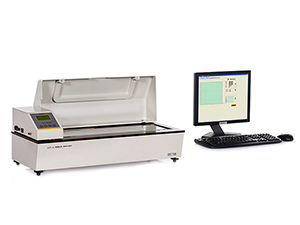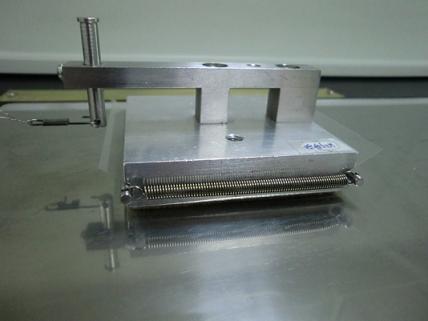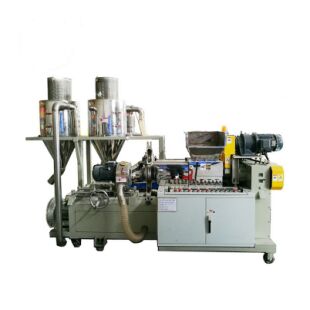Test significance In the cigarette packaging process, the friction between the smoke film and the equipment is both resistance and power, and the smoothness of the film is directly related to its friction coefficient. The friction coefficient can be divided into static friction coefficient and dynamic friction coefficient. The coefficient of static friction is the tendency of two objects to move relative to each other, but there is no coefficient of friction for relative motion. Dynamic coefficient of friction is the coefficient of friction when two bodies have relative motion. In order to adapt to the needs of high-speed packaging equipment, the proper friction coefficient is very important for cigarette packaging. According to the cigarette packaging process, there is a difference in the sliding properties of the inside and outside of the smoke film. In the cigarette packaging process, the inner layer of the smoke film is in contact with the cigarette box. In order to facilitate the accurate positioning between the cigarette pack and the smoke film and ensure the compactness of the cigarette pack, the inner surface of the cigarette pack needs a relatively high static friction coefficient. As for the outer surface of the cigarette pack, due to the close contact with the metal parts such as the lower film channel, the forming wheel slot, the folding plate, the iron, and the guide rail, and in a smooth gliding state, it is necessary to have a suitably low coefficient of friction. And, in the production process, most of these metal parts are operated under high temperature conditions (usually above 50 °C ), and the molecular motion state of the polymer materials used in the smoke film begins to be active, and the viscoelastic energy changes. As the temperature rises, the commonly used lubricants begin to become sticky and exhibit intermittent slippage, affecting the smooth operation of the tobacco film, and thus affecting the production efficiency and quality. Before entering into the production process, the friction coefficient of the film can be quantitatively evaluated by testing the friction coefficient of the film to minimize the production risk. So how to test the coefficient of friction of smoke film under high temperature production conditions? Test Methods Tester: LabthinkInstrumentsCo Ltd. FPT-F1 Friction / Peel Tester, which is suitable for moving normal professional equipment and related materials, plastic film, sheet or the like at a high temperature coefficient of static friction test, satisfy ISO8295, ISO 8150-2 , GB10006 , ASTM D1894 and many other international and national standards. The instrument adopts a high-precision sensor with a test accuracy of 0.5 . A wide range of high-precision temperature control devices can be used to easily perform test of the sample at different temperatures. Both the test bench and the test slider are demagnetized and remanently tested, effectively reducing system errors and improving test accuracy. Laboratory Environment: 23 °C , 50%RH Test material: BOPP smoke film Figure 1 BOPP smoke film Test steps: Take an appropriate amount of BOPP smoke film with a smooth surface, no creases, and no pinholes , cut it to a rectangular sample of 63 mm × 80 mm , and do not touch the test surface by hand during the cutting process. The outer surface of the test specimen is clamped on the outer slide and the test area is 63 mm × 63 mm . Open the FPT-F1 Friction Coefficient / Peel Tester, set the test parameters, set the test temperature to the desired temperature (eg 40 °C ), and turn on the heating control. Figure 2 FPT-F1 Friction Coefficient / Peel Tester Clean the equipment strips with absorbent cotton moistened with alcohol. After the temperature rises to the set temperature and stabilizes, the slider with the specimen is carefully placed on the steel strip vertically, and the slider is connected with the force sensor with a wire rope to test the coefficient of friction between the outside of the smoke film and the steel strip. Figure 3 loading diagram Click to start the test and the slider with the sample moves relative to the strip. At the end of the test, the friction coefficient results and friction curves are displayed in the software. Conclusion The FPT-F1 friction coefficient / peel tester can be used to test the static friction coefficient and dynamic friction coefficient of the specimen at different temperatures, and effectively predict the smooth running performance of the smoke film under high temperature conditions. In addition to testing the friction coefficient of plastic film and sheet, FPT-F1 can also test the dynamic and static friction coefficient of related materials such as paper, cardboard, communication cable, metal cable, conveyor belt, textile, paper, adhesive tape and so on. Adhesive composite products, medical patches, release paper, protective film and other products peel strength. Jinan Languang Electromechanical Technology Co., Ltd. has been committed to providing professional packaging quality testing programs and services to customers around the world. If you want to know about other physical property testing methods and testing instruments for packaging materials, you can visit the website of Jinan Languang Company or call us directly . . The more you understand, the more trust! Labthink is willing to take this opportunity to enhance technical exchanges and cooperation with enterprises and institutions in the industry. Copyright Notice: This article is copyrighted by Jinan Languang Electromechanical Technology Co., Ltd.
LINA Pelletizing-cooling Integrated Machine
LINA Pelletizing-Cooling Integrated pelletizing line centralizes all functions of a complete granulation line on one independent working platform. The pelletizing efficiency is 1-2 times higher than traditional masterbatch pelletizing production line. With the combination of PLC control system, LINA pelletizing-cooling integrated machine makes the granulation process easier, the working area smaller, labor cost lower and maintenance rate lower.
LINA CIM/MIM Twin Taper pelletizer
Twin taper forced feeding is adopted for mixed metal agglomerates, this feeding method is more efficient than traditional double wrist feeding method. Twin taper feeding is stable and feeding materials are uniform, it increases finished particles are uniform and full. This machine is specific for the granulation of high hardness, high strength and abrasion resistance materials, including stainless steel powder, iron powder, magnetic powder, zirconia, ceramic powder etc.
Main features
Oil shower lubrication system.
Material of barrel and screw: 38CrMoALA alloy steel nitride for 72 hours, polished and surface sprayed carbide.
Plunger type pelletizer (non-screw pelletizer): Feeding method of Plunger type pelletizer: hydraulic.
Applicable materials: High - end Inorganic nonmetal like zirconia ceramics.
Applicable to rare earth permanent magnet, magneto-optical, superconducting, hydrogen storage and other rare earth alloys.
Value Points:
1. Automation: Continuous kneading and pelletizing.
2. Eco-friendly: No gas masks needed while operating.
3. User-friendly: Quick release design for die head.
4. Modular: Based on user`s demand, manually material feeding can be updated to automatic weighted feeding.
Pelletizing-cooling Integrated Pelleting-Cooling Recycling Equipment,Pelleting-Cooling Integrated System,Pelleting-Cooling Integrated Recycling LINA Machinery Industrial Co.,Ltd , http://www.linakneader.com


